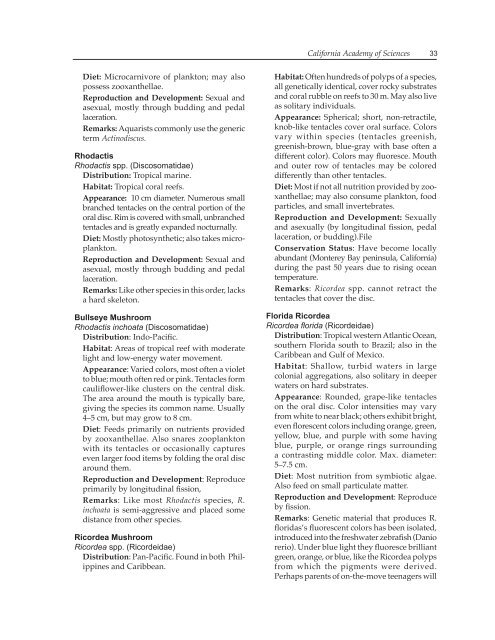THE STEINHART AQUARIUM - Gulf of Guinea Science ...
THE STEINHART AQUARIUM - Gulf of Guinea Science ...
THE STEINHART AQUARIUM - Gulf of Guinea Science ...
You also want an ePaper? Increase the reach of your titles
YUMPU automatically turns print PDFs into web optimized ePapers that Google loves.
Diet: Microcarnivore <strong>of</strong> plankton; may also<br />
possess zooxanthellae.<br />
Reproduction and Development: Sexual and<br />
asexual, mostly through budding and pedal<br />
laceration.<br />
Remarks: Aquarists commonly use the generic<br />
term Actinodiscus.<br />
Rhodactis<br />
Rhodactis spp. (Discosomatidae)<br />
Distribution: Tropical marine.<br />
Habitat: Tropical coral reefs.<br />
Appearance: 10 cm diameter. Numerous small<br />
branched tentacles on the central portion <strong>of</strong> the<br />
oral disc. Rim is covered with small, unbranched<br />
tentacles and is greatly expanded nocturnally.<br />
Diet: Mostly photosynthetic; also takes microplankton.<br />
Reproduction and Development: Sexual and<br />
asexual, mostly through budding and pedal<br />
laceration.<br />
Remarks: Like other species in this order, lacks<br />
a hard skeleton.<br />
Bullseye Mushroom<br />
Rhodactis inchoata (Discosomatidae)<br />
Distribution: Indo-Pacific.<br />
Habitat: Areas <strong>of</strong> tropical reef with moderate<br />
light and low-energy water movement.<br />
Appearance: Varied colors, most <strong>of</strong>ten a violet<br />
to blue; mouth <strong>of</strong>ten red or pink. Tentacles form<br />
cauliflower-like clusters on the central disk.<br />
The area around the mouth is typically bare,<br />
giving the species its common name. Usually<br />
4–5 cm, but may grow to 8 cm.<br />
Diet: Feeds primarily on nutrients provided<br />
by zooxanthellae. Also snares zooplankton<br />
with its tentacles or occasionally captures<br />
even larger food items by folding the oral disc<br />
around them.<br />
Reproduction and Development: Reproduce<br />
primarily by longitudinal fission,<br />
Remarks: Like most Rhodactis species, R.<br />
inchoata is semi-aggressive and placed some<br />
distance from other species.<br />
Ricordea Mushroom<br />
Ricordea spp. (Ricordeidae)<br />
Distribution: Pan-Pacific. Found in both Philippines<br />
and Caribbean.<br />
California Academy <strong>of</strong> <strong>Science</strong>s<br />
33<br />
Habitat: Often hundreds <strong>of</strong> polyps <strong>of</strong> a species,<br />
all genetically identical, cover rocky substrates<br />
and coral rubble on reefs to 30 m. May also live<br />
as solitary individuals.<br />
Appearance: Spherical; short, non-retractile,<br />
knob-like tentacles cover oral surface. Colors<br />
vary within species (tentacles greenish,<br />
greenish-brown, blue-gray with base <strong>of</strong>ten a<br />
different color). Colors may fluoresce. Mouth<br />
and outer row <strong>of</strong> tentacles may be colored<br />
differently than other tentacles.<br />
Diet: Most if not all nutrition provided by zooxanthellae;<br />
may also consume plankton, food<br />
particles, and small invertebrates.<br />
Reproduction and Development: Sexually<br />
and asexually (by longitudinal fission, pedal<br />
laceration, or budding).File<br />
Conservation Status: Have become locally<br />
abundant (Monterey Bay peninsula, California)<br />
during the past 50 years due to rising ocean<br />
temperature.<br />
Remarks: Ricordea spp. cannot retract the<br />
tentacles that cover the disc.<br />
Florida Ricordea<br />
Ricordea florida (Ricordeidae)<br />
Distribution: Tropical western Atlantic Ocean,<br />
southern Florida south to Brazil; also in the<br />
Caribbean and <strong>Gulf</strong> <strong>of</strong> Mexico.<br />
Habitat: Shallow, turbid waters in large<br />
colonial aggregations, also solitary in deeper<br />
waters on hard substrates.<br />
Appearance: Rounded, grape-like tentacles<br />
on the oral disc. Color intensities may vary<br />
from white to near black; others exhibit bright,<br />
even florescent colors including orange, green,<br />
yellow, blue, and purple with some having<br />
blue, purple, or orange rings surrounding<br />
a contrasting middle color. Max. diameter:<br />
5–7.5 cm.<br />
Diet: Most nutrition from symbiotic algae.<br />
Also feed on small particulate matter.<br />
Reproduction and Development: Reproduce<br />
by fission.<br />
Remarks: Genetic material that produces R.<br />
floridas’s fluorescent colors has been isolated,<br />
introduced into the freshwater zebrafish (Danio<br />
rerio). Under blue light they fluoresce brilliant<br />
green, orange, or blue, like the Ricordea polyps<br />
from which the pigments were derived.<br />
Perhaps parents <strong>of</strong> on-the-move teenagers will


